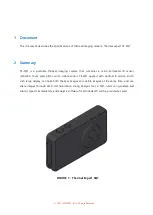
AXIS Q1961-TE Thermal Camera
The device interface
•
Refresh
: Click
to refresh the still image in the live view.
Click to show the live view at full resolution. If the full resolution is larger than your screen size, use the smaller image to
navigate in the image.
Click to show the live video stream in full screen. Press ESC to exit full screen mode.
Installation
Capture mode
: A capture mode is a preset configuration that defines how the camera captures images. When you change
the capture mode, it can affect many other settings, such as view areas and privacy masks.
Mounting position
: The orientation of the image can change depending on how the camera is mounted.
Power line frequency
: Select the frequency that is used in your region to minimize image flicker. The American regions
usually use 60 Hz. The rest of the world mostly uses 50 Hz. If you're not sure of your region's power line frequency, check
with the local authorities.
Rotate
: Select the preferred image orientation.
Image correction
Electronic image stabilization (EIS)
: Turn on to get a smoother and steadier image with less blur. We recommend you
to use EIS in environments where the device is mounted in an exposed location and subject to vibrations due to, for example,
wind or passing traffic.
Stabilizer margin
: Use the slider to adjust the size of the stabilizer margin, which determines the level of vibration to
stabilize. If the product is mounted in an environment with a lot of vibration, move the slider towards
Max
. As a result, a smaller
scene is captured. If the environment has less vibration, move the slider towards
Min
.
Image
Appearance
Contrast
: Use the slider to adjust the difference between light and dark.
Brightness
: Use the slider to adjust the light intensity. This can make objects easier to see. Brightness is applied after image
capture, and doesn’t affect the information in the image. To get more details from a dark area, it’s usually better to increase
gain or exposure time.
14















































